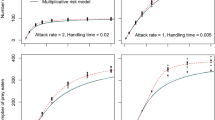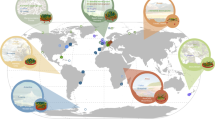Abstract
Apparent constancy in the ratio of predator species to prey species has been offered as evidence that ecological communities are structured by interspecific interactions. If significantly different from random expectation, this effect would be one of the few sound pieces of evidence for community structure. The evidence was re-evaluated by using the data from previous studies to form species pools, and forming simulated ‘communities’ by drawing species at random from these pools (with replacement). Using a correlation coefficient (number of predator species versus number of prey species), and also the statistic used by the original workers (where different), the observed predator:prey correlation was compared to that for the random communities. In five studies, the observed predator:prey ratio was not significantly different from random expectation. In the only two studies where there was significant departure from the null model, it was with more variation in the ratio than expected on a random basis. It is concluded that there is as yet no evidence for near-constant predator:prey ratios.
Similar content being viewed by others
References
Briand F, Cohen JE (1984) Community food webs have scale-invariant structure. Nature 307: 264–267
Closs G (1991) Multiple definitions of food web statistics: an unnecessary problem for food web research. Aust J Ecol 16: 413–415
Closs G, Watterson GA, Donnelly PJ (1993) Constant predator-prey ratios: an arithmetic artifact? Ecology 74: 238–243
Cohen JE (1977) Ratios of prey to predators in community food webs. Nature 270: 165–167
Cole BJ (1980) Trophic structure of a grassland insect community. Nature 288: 76–77
Colwell RK, Winkler CW (1984) A null model for null models in biogeography. In: Strong DR Jr, Simberloff D, Abele LG, Thistle AB (eds) Ecological communities: conceptual isues and the evidence. Princeton University Press, Princeton, NJ, pp 344–359
Connor EF, Simberloff D (1979) The assembly of species communities: chance or competition? Ecology 60: 1132–1140
Diamond JM (1975) Assembly of species communities. In: Cody ML, Diamond JM (eds) Ecology and evolution of communities. Harvard University Press, Cambridge, Mass, pp 342–444
Diamond JM, Gilpin ME (1982) Examination of the “null” model of Connor and Simberloff for species co-occurrence on islands. Oecologia 52: 64–74
Drake JA (1990) Communities as assembled structures: do rules govern pattern? Trends Ecol Evol 5: 159–164
Evans FC, Murdoch WW (1968) Taxonomic composition, trophic structure and seasonal occurrence in a grassland insect community. J Anim Ecol 37: 259–273
Gaston KJ, Warren PH, Hammond PM (1992) Predator:non-predator ratios in beetle assemblages. Oecologia 90: 417–421
Hall SJ, Raffaelli D (1991) Food-web patterns: lessons from a species-rich web. J Anim Ecol 60: 823–842
Heatwole H, Levins R (1972) Trophic structure stability and faunal change during recolonization. Ecology 53: 531–534
Jeffries MJ, Lawton JH (1985) Predator-prey ratios in communities of freshwater invertebrates: the role of enemy free space. Freshwat Biol 15: 105–112
Lawton JH (1987) Are there assembly rules for successional communities? In: Gray AJ, Crawley MJ, Edwards PJ (eds) Colonization, succession and stability. Blackwell, Oxford, pp 225–244
Lockwood JA, Christiansen TA, Legg DE (1990) Arthropod prey-predator ratios in a sagebrush habitat: methodological and ecological implications. Ecology 71: 996–1005
May RM (1988) How many species are there on earth? Science 241: 1441–1449
Mithen SJ, Lawton JH (1986) Food-web models that generate constant predator-prey ratios. Oecologia 69: 542–550
Moran VC, Southwood TRE (1982) The guild composition of arthropod communities in trees. J Anim Ecol 51: 289–306
Pimm SL (1991) The balance of nature? University of Chicago Press, Chicago
Pimm SL, Lawton JH, Cohen JE (1991) Food web patterns and their consequences. Nature 350: 669–674
Schoenly K, Beaver RA, Heumier TA (1991) On the trophic relations of insects: a food-web approach. Am Nat 137: 597–638
Simberloff D (1976) Trophic structure determination and equilibrium in an arthropod community. Ecology 57: 395–398
Simberloff DS, Wilson EO (1969) Experimental zoogeography of islands: the colonization of empty islands. Ecology 50: 278–296
Stork NE (1987) Guild structure of arthropods from Bornean rain forest trees. Ecol Entomol 12: 69–80
Sugihara G, Schoenly K, Trombla A (1989) Scale invariance in food web properties. Science 245: 48–52
Thomas CD (1994) Difficulties in deducing dynamics from static distributions. Trends Ecol Evol 9: 300
Tokeshi M (1986) Resource utilization, overlap and temporal community dynamics: a null model analysis of an epiphytic chironomid community. J Anim Ecol 55: 491–506
Van Valen LM (1982) A pitfall in random sampling. Nature 295: 171
Warren PH, Gaston KJ (1992) Predator-prey ratios: a special case of a general pattern? Phil Trans R Soc Lond B 338: 113–130
Warren PH, Lawton JH (1987) Invertebrate predator-prey body size relationships: an explanation for upper triangular food webs and patterns in food web structure? Oecologia 74: 231–235
Wilson JB (1991) Does Vegetation Science exist? J Veg Sci 2: 289–290
Wilson JB (1995) Null models for assembly rules: the Jack Horner effect is more insidious than the Narcissus effect. Oikos 72: 139–143
Winemiller KO (1990) Spatial and temporal variation in tropical fish trophic networks. Ecol Monogr 60: 331–367
Author information
Authors and Affiliations
Rights and permissions
About this article
Cite this article
Wilson, J.B. The myth of constant predator: prey ratios. Oecologia 106, 272–276 (1996). https://doi.org/10.1007/BF00328608
Received:
Accepted:
Issue Date:
DOI: https://doi.org/10.1007/BF00328608




